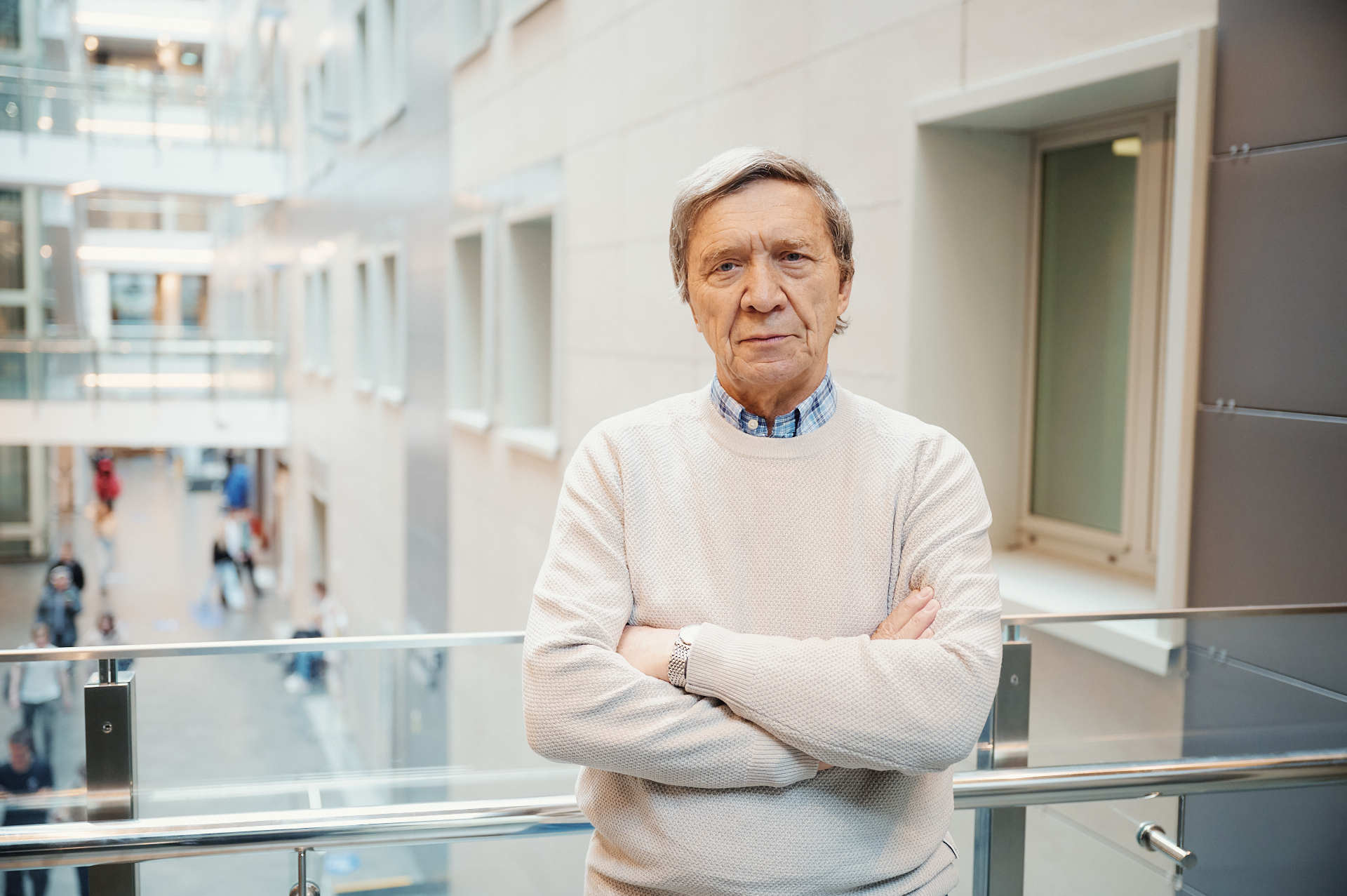‘HSE Is a Very Good Place: Intelligent Students, a Strong Teaching Staff’

Since March 2025, the HSE Faculty of Mathematics has welcomed a leading Russian mathematician, Doctor of Physical and Mathematical Sciences, Honorary Professor at the University of Edinburgh, National Professor of China, and recipient of the Lyapunov Prize—Sergey Kuksin. In an interview with the HSE News Service, he spoke about the role of the individual in mathematics, KAM theory, and why analysis is so relevant today.
— What brought you to HSE?
— A year ago, I received a mega-grant from the Government of the Russian Federation and began working at RUDN University, attending seminars in Moscow. When the grant ended, I was offered a position at HSE. I know many people at the Faculty of Mathematics at HSE. Mathematicians are all connected in one way or another. That said, mathematics is divided into three main branches: algebra, geometry, and analysis. You know what algebra is, right? For example, adding fractions, quadratic trinomials, ‘x plus y squared’ and so on. Geometry, as we all remember well, is about plane figures, construction problems, and the like. And analysis—that is about functions and graphs.
— And which one do you do?
— I do analysis.
— Have you ever been here before?
— Of course I have. HSE is a very good place: intelligent students, a strong teaching staff. Many years ago, I even gave a short lecture course at the Faculty of Mathematics here. But that experience was not particularly successful. The thing is, this faculty was originally set up by passionate algebraists and focused on algebra, so the students did not really connect with the course. They simply did not understand why they needed it. And that is a shame. Everyone needs to understand analysis. After all, analysis includes probability theory, which is highly relevant today, particularly because it is closely tied to topics like artificial intelligence, machine translation, and pattern recognition. The then leadership of the faculty understood this well, which is why they invited me to give the course. But in mathematics, to move anything forward, you have to make serious efforts. And it seems that is now happening—the faculty is broadening its scope. That is partly why I was invited.
— Will you be teaching or working as a researcher?
— Primarily, I will be working as a researcher. One of my main tasks is to help establish a seminar provisionally titled ‘Dynamics, Analysis, and Probability.’ I would like it to be a seminar of the highest calibre, with excellent speakers who inspire students to develop in this area. It is not easy, but it is achievable—especially since the push to strengthen the analysis unit is coming from the faculty leadership. In particular, this is thanks to the Dean, Alexandra Skripchenko, who recently defended her doctoral dissertation.

— What is your most vivid mathematics-related memory?
— My parents—I was very lucky with them—used to subscribe me to several magazines. One of them was Knowledge Is Power. Once, while I was still in secondary school, I read an article about mathematics in it. And there was a phrase that I remember to this day: ‘The peaks of mathematics are beautiful, and it is a pity that so few people can admire them.’ I wanted to admire them—and yes, I can confirm: they are beautiful.
— What qualities does one need to become a good mathematician?
— You know, mathematics is, fortunately, a gift—and it tends to show itself early. Or it does not. In other words, a person realises while still at school whether mathematics is for them or not. Already by the time I was in upper secondary school, I could not imagine doing anything else with my life.
— Which of your scientific achievements do you consider the most significant?
— Let me start from afar. There was a scientist, Andrey Kolmogorov—the most prominent Soviet mathematician. He was an absolutely extraordinary person who made a tremendous contribution to mathematics. Among other things, he was a founding figure of KAM theory. That is an acronym formed from the initials of the three authors: Kolmogorov, Arnold, and Moser. Now let us try to understand what KAM theory is. Take the Solar System, for example. Usually, we consider the five major planets from Venus to Saturn. We know that each planet orbits in an ellipse—according to Kepler’s laws. That is because the Sun attracts them. But in addition, the planets interact with each other. As a result, their Keplerian motion gradually becomes distorted. There is a relatively simple equation that describes how a planet interacts with the Sun. But when we account for the interactions between the planets themselves, small perturbations are added to this basic equation. Because of these interactions, the planets’ orbits slowly begin to deform. The question, posed as far back as by Isaac Newton, is: what will happen to these ellipses in, say, a million years? Either an orbit might break apart, causing a planet to fly off into deep space. Or the ellipse might become so elongated that the planet falls into the Sun and burns up. Or two planetary orbits might intersect, leading to a collision. Not within the next ten thousand years, of course—but still, it is a valid concern. This was an outstanding and fascinating problem—and it was solved using the KAM theory.

— And what is the answer?
— The answer is negative: the orbits will always remain close to the original ones. The precise formulation is more complex and includes important caveats, which would be inappropriate to go into here. But this simplified explanation gives a fairly accurate idea of what KAM theory says. Now, in answer to your question about my contribution to mathematics: I learned how to carry out calculations for systems with not five, not even five hundred, but infinitely many components. This was the subject of my doctoral dissertation, 'KAM Theory for Partial Differential Equations.’
— Was that the work for which the Russian Academy of Sciences awarded you the Lyapunov Prize?
— Yes, that is right: for developing and extending the Kolmogorov–Arnold–Moser theory for partial differential equations.
— What would you like to achieve while working at HSE University?
— I would like to contribute to the development of analysis—both at HSE in particular and in Moscow more broadly. During the Soviet era, analysis was very strong here, but for various reasons it has significantly declined (unlike algebra, for instance). This reinforces the idea that individuals shape history—because the preservation of algebra in Moscow is down to a handful of outstanding algebraists who never left the city. They kept the seminars going and kept young people coming to them.
— Would you like to be the figure in mathematics who pushes analysis forward?
— I would like to take part in this effort.
See also:
HSE University Wins Seven Medals at International Mathematics Competition for University Students
HSE students were among the winners of the International Mathematics Competition for University Students (IMC), which was held in August in Bulgaria. The medallists are students of the HSE Faculty of Computer Science (FCS) programme in Applied Mathematics and Information Science and the Faculty of Mathematics programme in Mathematics.
‘Our Result Was Recognised Not Only Within the Project Defence but Also on International Scale’
This year, the European AI Conference (ECAI 2025) accepted an article titled ‘Multi-Agent Path Finding for Large Agents is Intractable’ by Artem Agafonov, a second-year student of the Applied Mathematics and Information Science Bachelor’s programme at HSE University’s Faculty of Computer Science. The work was co-authored by Konstantin Yakovlev, Head of the Joint Department with Intelligent Technologies of System Analysis and Management at the Federal Research Centre ‘Informatics and Management’ of the RAS and Associate Professor at the Faculty of Applied Sciences. In the interview, Artem Agafonov explained how he came up with the idea for the article and how he was able to present it at an A-level conference.
'Today, Human Existence Without Mathematics Is Difficult; Tomorrow, It Will Be Simply Impossible'
Mathematicians around the world share a common language and continue to collaborate despite the challenges of recent years. The hub of mathematical networking has been shifting to China, where scientists from various countries meet at conferences and other academic events. Partnerships with leading Chinese universities offer promising opportunities to strengthen existing ties and forge new ones. In this interview with the HSE News Service, Valery Gritsenko, Head of the HSE International Laboratory for Mirror Symmetry and Automorphic Forms, discusses this and other topics, including what AI is and why the state should engage with mathematicians.
HSE Scores Best Results among Russian Universities at International Olympiad in Uzbekistan
At the Third Al-Khorezmi International Mathematical Olympiad (AKHIMO), held at Urgench State University in Uzbekistan, students from HSE University's Faculty of Computer Science scored best results among participants from Russian universities. The olympiad also featured contestants from Brazil, the USA, China, India, South Korea, Malaysia, Japan, Vietnam, Serbia, Kyrgyzstan, Kazakhstan, Tajikistan, Turkey, Turkmenistan, and Uzbekistan.
Russian Scientists Assess Dangers of Internal Waves During Underwater Volcanic Eruptions
Mathematicians at HSE University in Nizhny Novgorod and the A.V. Gaponov-Grekhov Institute of Applied Physics of the Russian Academy of Sciences studied internal waves generated in the ocean after the explosive eruption of an underwater volcano. The researchers calculated how the waves vary depending on ocean depth and the radius of the explosion source. It turns out that the strongest wave in the first group does not arrive immediately, but after a significant delay. This data can help predict the consequences of eruptions and enable advance preparation for potential threats. The article has been published in Natural Hazards. The research was carried out with support from the Russian Science Foundation (link in Russian).
'The Six Handshakes Rule Applies to Social Media'
Ivan Samoylenko specialises in graph theory; in his third year of university, he developed an idea that later became the foundation of a highly cited academic article. In this interview with the HSE Young Scientists project, he speaks about the Watts-Strogatz small-world model, being a performer in the Bolshoi Children's Choir, and making the choice between science and industry.
Scientists Disprove Bunkbed Conjecture
Mathematicians from Russia, including two HSE graduates, have disproven a well-known mathematical conjecture that, despite lacking solid proof, had been considered valid for 40 years. The ‘Bunkbed Conjecture’ belongs to percolation theory—a branch of mathematics that studies the formation of connected structures in independent environments.
'Our Mathematics Is for Far-Reaching Minds'
Anna Presnova focuses on automatic control theory, a branch of science that addresses global problems. In this interview with the HSE Young Scientists project, she talks about her aspiration to achieve practical results, the energy she gains from teaching, and why she would be interested to meet with Alexandr Lyapunov, founder of stability theory.
'It Was a Great Learning Experience for the New Generation of Mathematicians'
From November 5 to 9, 2024, HSE University hosted a five-day conference on algebraic geometry and mathematical physics, organised jointly with the Beijing Institute of Mathematical Sciences and Applications. Over 30 mathematicians from the world's leading universities, including early-career scientists, participated in the event.
HSE University Wins Two Medals at the International Mathematics Competition for University Students
Two students, one graduate and one undergraduate, from the HSE Faculty of Computer Science (FCS) programme in ‘Applied Mathematics and Information Science’ won prestigious awards at the International Mathematics Competition for University Students (IMC). Graduate Maksim Kazadaev and first-year student Daria Linichenko both represented HSE University at the IMC, winning gold and silver medals respectively.


